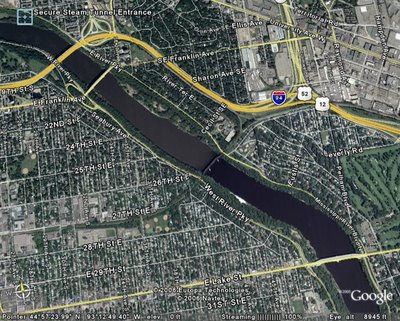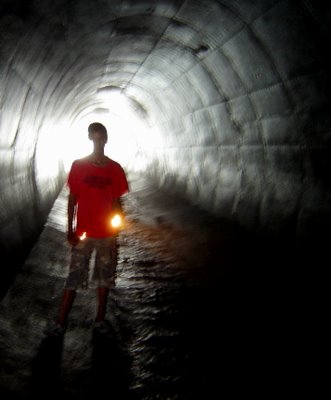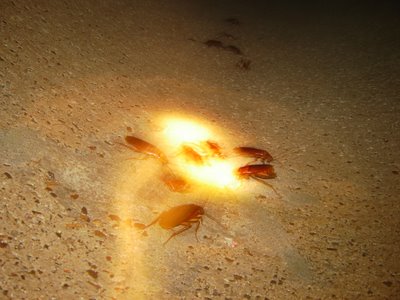
(I've omitted some of the locations we explored from this map, due to the fact that either I don't wish to make there entrance points over-obvious, or I can't place them exactly on the map by memory.)
Location: East Bank of Mississippi River, near the **** St. Bridge
Crew: Rataphobe & Spaz (me)
Mission Time: 2 hrs, 40 mins
Difficulty: Moderate
The West Kittsondale (Triple Helix) Drain:
Today we set out with two objectives:
- Explore the Minnehaha Amphitheater Drain.
- Locate the West Kittsondale (Triple Helix) Drain entrance.
Locking our bikes up, we climbed down a steep, sandy embankment beneath the bridge, and made our way over to the concrete tunnel we had seen from across the river. There was actually a smaller brick tunnel adjacent to Kittsondale entrance, and we decided to explore it first. It was of walkable height, but ended quickly at the foot of a dropshaft.

The steep sides of the tunnel made it difficult not to get our feet wet.

No, the roof didn't collapse, it seems that the tunnel's builders found the sandstone stronge enough to warrant not spending the time to add in an unnecessary layer of bricks. That, or a cheap sub-contractor was trying to cut costs.
Next, we dropped into the large concrete outfall of the Triple Helix Drain, and the mist that poured from the gaping entrance. This thing is big, big enough to drive a car into. It even crossed our minds to ride our bike's in next time (if we didn't mind going through the inches of water that flowed through the center).

Looking back at the entrance of the West Kittsondale Drain.

Rato in the sewer.

There was something extremely photogenic about this part of the tunnel. Too bad the rest was chocked with mist.
So we pushed on, jumping over the stream of water, from one side to another, to avoid the occasional waterfalls that poured in from the ceiling, filling the already dank air with drops of water that made photography in most of the drain impossible.

Visibility was nearly nill. There is one of those water falls here too, somewhere behind all this mist... I think.
Not too far in we found a set of rungs leading up the side of the tunnel, into a small hole in the concrete over our heads. As I stepped beneath it, I was hit with a blast of air. There was a continuous wind blowing out and down into the tunnel from it. I climbed up and looked in. The air, again, was very thick, making photography all but impossible. I emerged into what appeared to be a very tall concrete tunnel. At my level was metal grating, over six feet beneath me, was the tunnel floor. The roof was high enough to making walking atop the grating easy, but I didn't trust it and was concerned about the source of the air, so we decided that we should continue down the main tunnel, in search of the "helix" spiral staircases that give this drain its name. I have no idea what that place was, if anyone has any idea, leave a comment, I'd like to know!
This tunnel had the worst visibility of any underground place I have ever been in. The air, especially near waterfalls, was thick with large water particles and slime that floated through the air. Not only does it hamper photography, but makes breathing unpleasant, and cuts the effectiveness of flashlights. My Mini-Mag could barely reach over a dozen feet, and my LED head lamp was nearly useless.
Eventually, we found a side tunnel. The air was about as thick as where we were coming from, but there was hardly any water so we started down in. The roof was low, low enough that I hit my head once when I wasn't paying attention to it. The tunnel turned to the left, and pretty soon, we came to what looked like a stair case. We had reached the first helix.

Water flows down the stairs at the base of the helix.
I'm not great at judging distances, but we climbed a long way up the stairs, of which the steps were rather small and seemed to be made with the idea the people might need to climb them in-mind.

The designers may have chose to add these steps to avoid the erosion that would otherwise be caused by water dropping such a long distance.
We reached the top of the stairs winded, and entered a room, with a hole in a wall leading to a manhole shaft high above, and a large circular culvert leading a short distance to another dropshaft. We took our first break of the entire day before we stated back down the helix, to push on further into the tunnel.
Video from on the way back out.
We didn't go much further into the drain. The roaring sound of what we hoped would be a massive waterfall turned out to be just a large volume of water flowing swiftly out of a side tunnel. It kicked up a disproportionately large amount of mist though!
So we turned back. Having spent over an hour walking at least a mile into the drain, we set our sites up-stream, at some of the smaller ones we had spotted on the way down.

Part of a fish vertebrae Rato found on the beach near the outfall.
East River Flats Tunnels:
The rest of the tunnels we explored were in what is called the East River Flats, a park and recreation area along the river. Here were several very interesting tunnels that are likely often passed up due to there small size.
The first was close to the path, and difficult to get into with out getting ones feet wet. Bending over I started into the small brick tunnel. Very soon, the tunnel started to slope up, enough that I was worried about slipping on the slick bricks. The bricks that were placed down the center of the tunnel, over which the water flowed, were red, and surrounded by a troff of concrete, while the roof of the tunnel was constructed out of orange brick.

Looking down the tunnel (you can make out where it levels at the base), I got the idea that after a rain storm, this tunnel would make an excellent water slide, if you brought something like a lunch tray to sit on.
Just a soon as I was really starting to appreciate the work done on this drain, it stopped. The drain ended at the base of a dropshaft not far from where the picture above was taken.
Biking on, we found, on the outside at least, another intriguing drain. The tiered outfall led back into a rather large brick tunnel. Walking back into it, we came to (surprise!) another dropshaft.
Then, I found something really interesting. At first glance, I barely thought anything of it, a concrete pipe, barely two feet in diameter, with a trickle of water running out of it, into the river. As I got closer, I noticed something odd. There was steam coming out of it. That got my attention. Inside, another surprise, roaches. I have never seen roaches in a storm sewer before. They like warm, damp places. Drains are usually cold, that is unless they link to, say, a steam tunnel.

Cockroaches in the pipe.

The roaches were definitely not a factor in why we did not investigate further.
Time was starting to run short, so we left the steaming pipe.
Not far from the pipe, we came upon a steam tunnel entrance that I remember seeing on a map of the system. Locked up tight, but it did get me thinking even more about the pipe.

The entrance, with an "oh so intimidating" amount of warning signs.

What the flashy signs failed to do, a locked steal gate did, but there is always another way in.
So we didn't make it to Minnehaha, but I'm not sorry. What we found was far more interesting (I'm not even convinced that it doesn't just end a few yards at the foot of a drop shaft).
Still to come:
Pushing deeper in to the Triple Helix, and finding the source of our "steam pipe".

1 comment:
i think i finalt figured out how to slid down that drain. i have this 20g buket that i think would work remarkably well.
Post a Comment